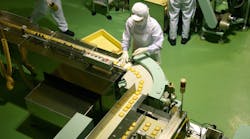The pandemic shook up a lot of industries, especially food & beverage. What remains to be seen is how much resentment will linger among its workforce.
The pandemic either created or exacerbated what have become chronic labor problems: absenteeism; the need for workers far outstripping the supply; an aging workforce whose retirees aren’t getting replaced; the arduous nature of the work, and other factors. And by all indications, many such problems remain.
There’s no doubt the demand for labor remains. It crops up repeatedly in executive remarks during quarterly earnings calls, such as Jim Snee, CEO of Hormel Foods, discussing Hormel’s third-quarter results: “What we are seeing is that [workers are] not staying, that there is higher than normal turnover, there's significant absenteeism. And we do think that’s partly driven by the labor market that we've had, the ability to find many jobs elsewhere.”
It's a widespread situation. According to the Consumer Brands Assn., job openings in the consumer packaged goods (CPG) sector hit 113,000 in August, up from 98,000 in July. This is reflective of the economy as a whole, where employers of all types are having trouble filling jobs. There were 10.7 million open jobs in the U.S. in June but only 5.6 million unemployed people looking for work, according to statistics cited by Corey Chafin, an associate partner of consulting firm Kearney.
“The pandemic has led to a collective re-evaluation of work and what employees expect,” Chafin says.
Worker-management tensions
Some of those expectations have been expressed on picket lines. Kellogg Co., Mondelēz International and Frito-Lay all saw strikes last year that resulted in substantial concessions to their workforces. At press time, a strike was ongoing against a Hormel plant that produces Corn Nuts in Fresno, Calif.
Other workers have sought relief in court. Three of the biggest U.S. poultry processors agreed in September to settle, for a collective $84.8 million, a lawsuit brought by workers who charged they were victims of a conspiracy to keep their wages low. The three companies – Sanderson Farms, Wayne Farms and Cargill Meat Solutions – had paid a comparable fine to the federal government over a similar case.
The pandemic laid bare ongoing tensions between workers and management – and created plenty of fresh ones, according to David Woods, International secretary-treasurer with the Bakery, Confectionery, Tobacco Workers and Grain Millers International, the union that called the strikes referenced above. Woods was involved in BCTGM’s strikes last year and was the lead negotiator in the Kellogg one.
“I think it was exacerbated a lot during COVID, but I don’t blame it all on COVID, because I think that it was all deteriorating prior to COVID,” Woods says.
Much of the tension that led to last year’s strikes centered on the usual factors: pay and hours. As with many workplaces, health care costs were a big factor. The current job action at Hormel’s Corn Nuts plant was undertaken in large part because when Hormel bought the Planter’s brand, which includes Corn Nuts, from Kraft Heinz in 2021, it sought to triple the portion of health-insurance costs borne by workers, according to Woods. (Hormel said in a statement, “We have been working closely with union representatives on a new collective bargaining agreement that is consistent with our total rewards program,” but did not respond to the allegation of tripled health costs.)
But many of the precipitating factors for the strike were made worse by the pandemic. Foremost among these was short-staffing that led to mandatory overtime and strings of consecutive days with no time off.
As Woods sees it, the problem is that when COVID hit, many companies, in the food sector and others, simply stopped hiring. It was the first, confused reaction to a situation that no one knew how to deal with, and it backfired.
“I don’t blame that all on the companies, but they didn’t have the foresight to see that they had to still hire people” he says. “People were being laid off around the country – there was a workforce there to hire. But they chose not to hire anybody, and they chose to work the people they had a lot of excessive overtime, a lot of hours.”
Short staffing is still a major concern across the industry, Woods says: “I can’t say I’ve got any local union I’ve talked to in our international union that doesn’t have a shorthanded workforce right now.”
A hard job
The food industry faces some daunting obstacles when it comes to attracting workers. Arguably the foremost is the unpleasant nature of the work itself. Many plants are, unavoidably, uncomfortable environments: noisy, dusty, hot or cold, with physical hazards ranging from falls to repetitive-motion injuries.
It’s hard for such work to be appealing, especially when other manufacturing jobs are available nearby. That increases the strain on the existing workforce, especially if the plant needs to crank up production to meet demand, which happened often during the pandemic. This kind of inflexibility will drag down worker retention in the long run.
“Workers have reported they understand that working in the food industry comes with less flexibility depending on the job,” says Ernest Raskin, an associate professor in the food, pharma and healthcare department of St. John’s University. “However, they redefined flexibility to mean predictability – they would like a focus on predictability. In other words, they want to know when their shifts are ahead of time and don't want them to be changed at the last minute.”
Another chronic challenge in plant workforce hiring is simple wage disparity. According to U.S. Dept. of Labor statistics, as of August, food manufacturing wages average about 84% of the prevailing overall manufacturing wage. Given the tight margins under which the industry operates, this differential probably won’t be remedied anytime soon, although individual companies are starting to nudge wages upward. Tyson Foods and Foster Farms, two of America’s biggest poultry processors, have instituted pay increases in the past year, with Foster raising the starting salary at its plant in Kelso, Wash., to $19 an hour.
Numerous companies offered front-line bonuses to their workers during the pandemic, but the goodwill engendered tends to dissipate over time, especially if the bonuses are followed by additional worker-management tension.
“They put in the hours at work and were held and patted on the back, told how great they were doing, but then all of a sudden, now it’s like, well, we need you to take these concessions, these takeaways,” Woods says.
Other companies are offering more extensive, longer-lasting perks. Tyson Foods, for example, offers continuing education in fields ranging from English to job-related skills like maintenance.
Education like that isn’t just a perk for employees; it’s very much in the self-interest of companies like Tyson. One of the industry’s major labor concerns going forward will be a dearth of workers for skilled positions, like mechanic or electrician. Competition for such workers is even more intense than for unskilled labor, and it will only increase as workforce retirements increase.
“Right now, every company we deal with is shorthanded in those fields, because there’s so much competition for those skill-based mechanics and electrical people,” Woods says.
Train or pain
Training for any job in a plant, no matter the skill level, is a major point of worker dissatisfaction. It’s a huge challenge, especially in times of high turnover.
“There's work to do in terms of training and retaining those people so that we do, over time, develop that experience. That is a problem today,” Hormel’s Snee said in the third quarter earning call.
There’s little question that an influx of untrained individuals will have a negative effect on any plant’s operation, as Kellogg found out when it tried to keep its cereal plants operating during the strike with temporary workers and white-collar personnel. According to Woods, it takes six to nine months of training before a worker can reliably operate alone one of the giant ovens in those cereal plants.
“That was a company that really didn’t understand what their workers contribute to the company,” Woods says. “They didn’t understand the experience and the knowledge and the safety that the workers have, and that they’re worth the money and the value that they get every day.”
Kellogg spokesperson Kris Bahner said in a statement, “We have a long history, spanning many decades, of positive labor relations across our manufacturing plants. At our cereal plants, in particular, we ultimately reached a new five-year agreement last year that continued to provide employees with fair and competitive wages and benefits.”
Automation not a panacea
Over the long term, automation could be the solution to many labor-related problems, especially when it comes to the most unpleasant and/or dangerous tasks in a food plant. Some companies are investing in automation in a big way, especially in the meat sector, where unpleasant and dangerous tasks abound.
Tyson Foods, JBS USA and others have ambitious development programs for robotics that can handle carcass disassembly and further cutting. Tyson established a Manufacturing Automation Center in 2019, a two-story, 26,000-sq.-ft. facility to try out robotics and other advanced automation such as machine learning.
Automation, however, is no panacea – at least not now. Many of the tasks in a food plant require flexibility, delicacy, adjustment – attributes that just are not yet reliably replicable by robots or other equipment.
“Automation is not a solution to the labor shortage for the CPG industry,” says Joseph Aquilina, senior director and associate general counsel for the Consumer Brands Assn. “This is a human powered industry that depends on its workers to deliver for consumers every day.”
Chafin suggests that automation may be more of a long-term solution: “Automation takes time to implement, it is not an immediate fix to address hiring and attrition needs, but must be part of the long-term workforce strategy for most companies.”
Until automation fully takes hold, food & beverage companies will have to do whatever they can to improve incentives and working conditions if they want to attract adequate workers. Aquilina says manufacturing wages in general are rising faster than the national average for all salaries; in August, they went up 7.5% over last year.
“Beyond compensation, CPG companies are holistically examining ways to provide more work-life balance, shift flexibility and additional time off,” he adds.
Woods believes that medical insurance is a big part of the picture in many cases. “Health care is a major, major cost that companies have been passing on to the workers for many years now, and it’s coming to a head,” he says. “They’re asking for too much.” A truly good health package would be a significant attraction, he believes.
The food industry is still grappling with “The Great Resignation” – the outflux of workers from the labor force in 2020-2021, when they found themselves with alternatives to taking, or continuing in, undesirable jobs. Food & beverage processors with labor problems will have to figure out a way to make their unfilled positions more desirable – or at least, less undesirable.

